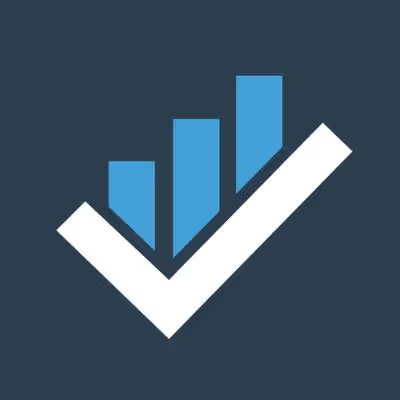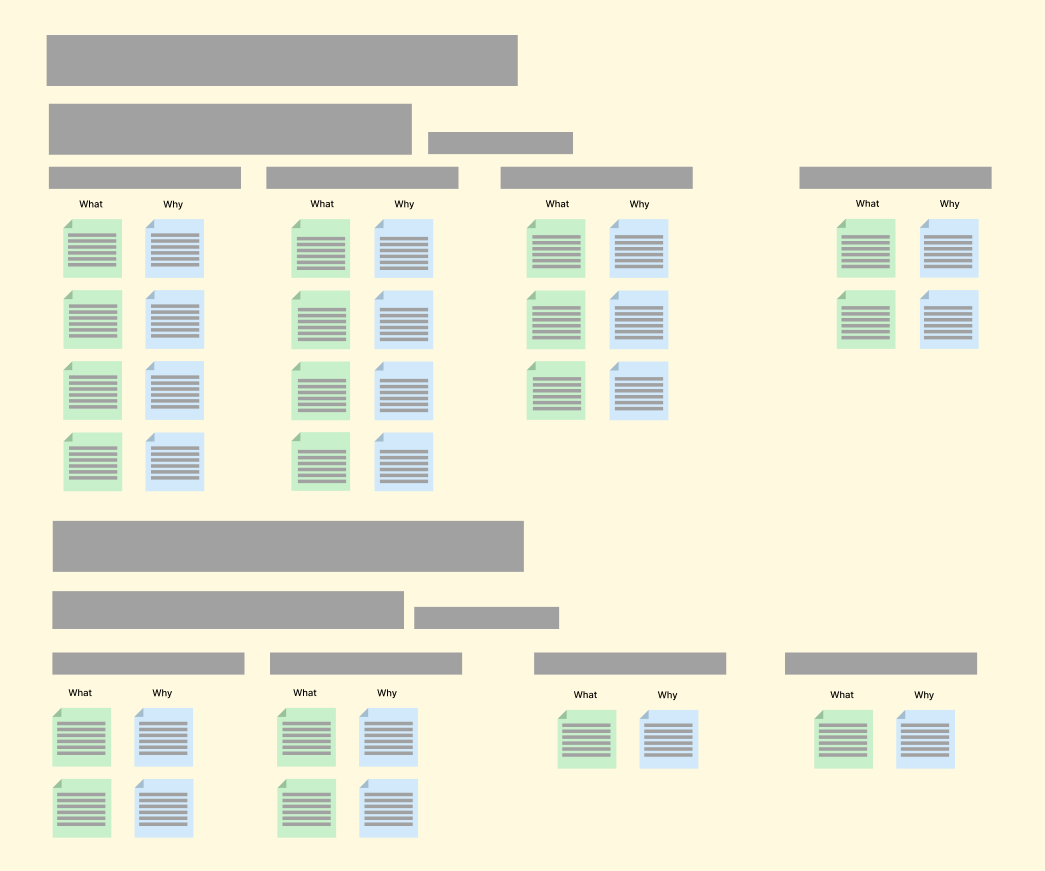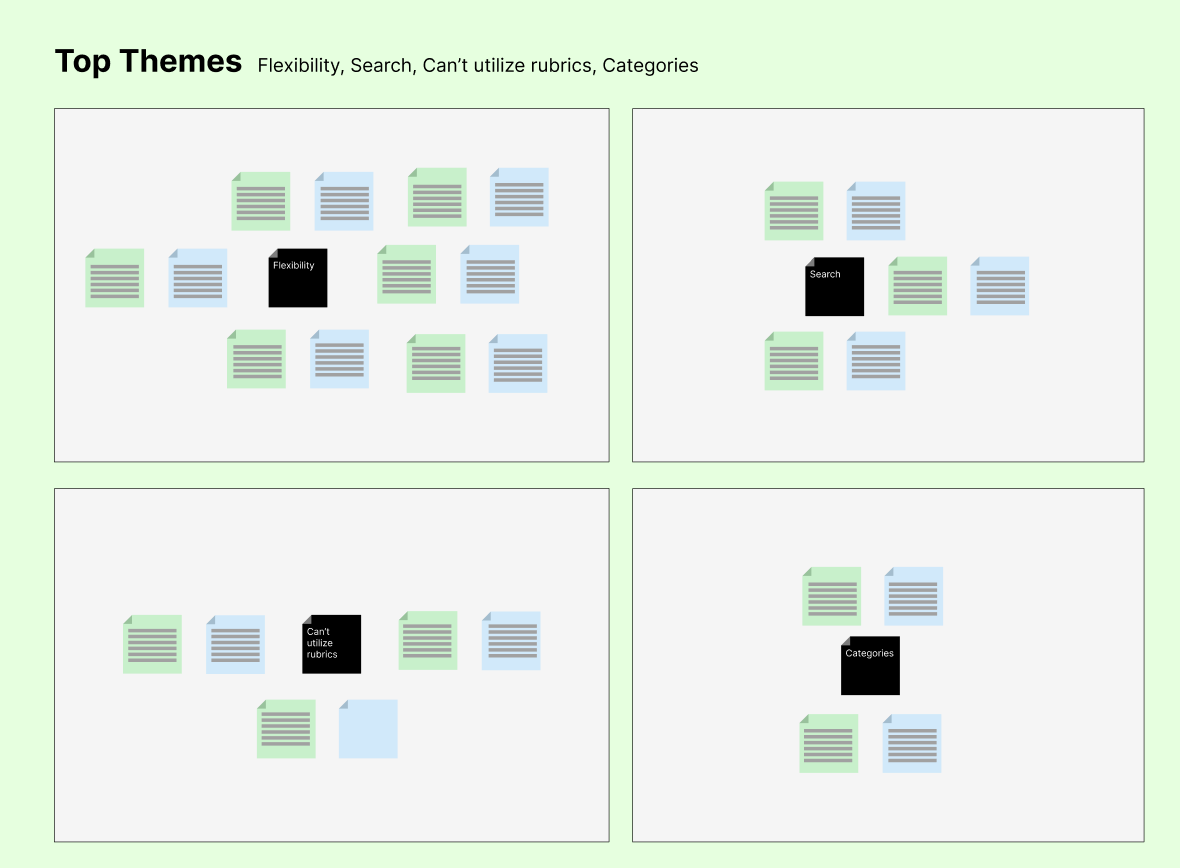
ExamSoft - New Category Tagging for Test Questions & Advanced Reports Improves Usability
ℹ️ All research documents, workflow diagrams, prototype, and final mockups are removed to protect the company’s confidential and proprietary information. Assets that are featured have been modified with proprietary information removed.
Overview
This project for improving the experience of tagging categories to questions came about during my UX audit of our testing platform. Digging deeper into our internal knowledge base, I discovered that past user interviews were done six years ago but have not been reviewed since. After going through all the interviews, I organized the pieces of important feedback into common themes, but the one theme that stood out was Category Tagging.
Lessons
Learned how to format and structure user interview documents based on existing ones reviewed for this project, and carried this over to my unmoderated user test for ExamSoft's AI question generation
Practiced creating templates in Figma for use in future UX workshops
Showcased multiple ways to improve the experience to drive conversation with stakeholders, in order to align on a path forward
Adopted new methods for communicating with stakeholders to align on customer and business goals, in order to close communication gaps and prevent frequent reworking of designs
My Role
I was the lead UX Designer who used the following methods to successfully receive full buy-in from stakeholders within an agile environment:
- Analysis of User Research
- Written Scope Document
- User Flow Diagrams
- Wireframes
- Prototype
- Final Mockups
Stakeholders
- Product Managers
- Developers
- Customer Onboarding Specialists
Tools
- Figma
- Google Docs
Timeline
Foundational Deliverables: December 2023 – February 2024
Development & Release for Advanced Reports: February 2025 – June 2025
- Development & Release for Questions: December 2025
What is ExamSoft?
A complete assessment integrity platform that includes:
- Enterprise Portal for institutions responsible for creating and releasing hi-stakes assessments that include questions, both new or existing ones, that are aligned with required learning outcomes
- Examplify for test takers that may enable the following ExamIntegrity products
- ExamID for verifying the identity of test takers
- ExamMonitor proctoring service that records the test taker's screen and webcam footage during the assessment
Why are Categories Important?
Customers use categories for the following:
- Ensure that course material is aligned with required learning outcomes for accreditation
- Generate reports of how well test takers did demonstrating their knowledge of each category, allowing for more informed decisions around modifications to course content
Category definitions:
Category Type – a top-level category that contains its own tree with infinite levels
Category Tree – a tree of nested levels similar to a folder tree, where a folder can contain subfolders within
Category – an item similar to a folder, but represents a test topic
Parent – the category of which the child categories live
Child – a category that is within the parent category
1
Challenges
How stakeholders once viewed this proposal due to lack of data to justify the development and implementation of a new experience for category tagging.
- Not Important – Proposal for new UX was viewed as a minor bug rather than a design problem to be solved
- No Value – Concern from stakeholders that a redesign of category tagging wouldn’t provide a huge win for customers or the business
- Cost of Development – had to constrain this project to a medium size that strikes a balance between utilizing convergent and divergent thinking
2
Qualitative Analysis
To find justification for developing a new experience for category tagging, the following steps were taken:
Research Audit – Analyzed all feedback from two user interview documents compiled in 2016, retrieved eight points of feedback that stood out to me, and laid out most important findings with both the What and the Why behind each one. This step was necessary before identifying four top themes of growth and opportunity. All details in these diagrams have been removed to honor the privacy of customers.
Grouping Key Themes – Identified 4 common themes from the feedback and singled out category tagging as the most important but overlooked user problem negatively impacting the business. Now that I had qualitative data to prove the existing category tagging experience was an issue, it became easier for product managers to have greater confidence that developing a new experience for category tagging would be necessary.
Results – These activities lead to developing a full grasp of the features most important to our customers, less resistence from product managers to creating a new experience for category tagging, and highlighted a serious customer need that was overlooked


3
Documenting Customer Pain Points
Once category tagging was identified as a problem that needed to be solved, a worflow diagram of the former experience was created to detail each step the user had to take to utilize categories in their workflow. The workflow diagram listed the following issues:
- When the popup showing the list of all category types is opened, results further down the list are cut off from the view of the slider making long scrolling a must
- There is no save or tag category types button anywhere in the popup that the user clicks on to confirm their selections
- To close the popup, the user must click outside of it with a mouse (impossible for users who rely on a keyboard)
- The popup does not allow for users to create new category types on the fly, yet it is possible to create new subcategory for a category type without ever needing to leave the slider
- Cannot search for category types to tag, yet can search for subcategories within a category type
- To untag category types from a question, the user must open the popup to manually unselect them to officially remove them, while subcategories can be easily removed by simply clicking its corresponding remove icon
- If the user presses the enter key to try to select a category type, a new case study appears for no apparent reason
4
Customer Adjectives
The customer paint points communicated that the category tagging experience was:
- Inaccessibile
- Inconsistent
- Inflexible
- Unpredictable
- Inaccurate
- Incomplete
- Distracting
To address these adjectives, the following changes needed to be made:
- The popup is to be removed and replaced with an existing component that is used across the entire ExamSoft portal instead of a pop up customers are less familiar with
- Remove the ability to create new subcategories on the fly as it is not aligned with customer expectations and is inconsistent with the rest of ExamSoft's Enterprise portal
- Both category types and subcategories can be removed by clicking its corresponding remove option
- Be able to browse through different points of the tree to select categories
- Keep track of points of the tree that have selections to prevent cognitive overload
- More easily modify or remove selections even after they’ve been added to a question
- Utilize a Save button to confirm selections
With these changes, the new adjectives are:
- Accessible
- Consistent
- Customizable
- Predictable
- Precise
- Focused
5
Presentation to Product Managers
All the deliverables of the research audit, top key themes, and customer pain points were presented to product managers with the following takeaways to secure full buy-in on this project:
- Feedback on category tagging from user interviews have been stored in our database since 2016, yet had not been addressed by our product roadmap
- Current experience is inaccessible and will be a future violation
- Each step in the process communicates false and misleading information to our customers by giving the impression that they are adding categories when they are actually adding category types
6
Business Problem
- Greener Pastures – Our customers utilize categories to group questions in subject areas to ensure alignment with accreditation. Failure to meet users’ needs may push institutions to switch to more customer-centric products
- Slow Reputation – When customers demand a change that’s important to them, they want it soon. Failure to respond to customer feedback in a timely manner will result in customers viewing the company as unable to adapt to changing workflows
- Pays Dividends – The amount of rework it will take to work around the current category tagging UX is more expensive than a new UX that will serve customer needs well into the future
7
User Archetypes

Administrator – The test administrator is responsible for overseeing the entire curriculum of an academic program. The most important responsibility of the role is ensuring all tests, questions, and rubrics are aligned with the program’s requirements. Test administrators work closely with test makers who receive feedback on test quality from test reviewers
How the former experience impacted these customers:
- The long popup which was cut off from the screen did not allow test administrators to get an accurate list of their category tree, which made it difficult to select the necessary categories to add to questions or new reports
- The unpredictable nature of modifying selections meant administrators lacked confidence in their ability to organize course content by category
- Admininistrators struggled to make accurate reports to track assessment performance

Maker – The test maker creates questions that go into an assessment. Previous user research shows that assessment making is a collaborative process that involves receiving feedback from assessment reviewers. Instructors do not make the assessments
How the former experience impacted these customers:
- With the lack of confirmation of changes made, test makers lacked confidence they were creating questions for the right topic
- Any changes were difficult to implement, which obstructed the assessment making process

Reviewer – The test reviewers are members of a review board that provide feedback on tests
How the former experience impacted these customers:
- Reviewing category performance was difficult
- Results from advanced reports returned inaccurate information
8
Ideation
Workflow diagrams were created to explore two directions with product managers. After presenting these two options, product managers preferred option 1 as it utilizes our existing slider component, and allows for customers to browse and select their categories just like in the Category Management page of their portal.
Option 1
Involves all of the navigation, search, and selection happening within the existing slider component. This option was chosen by the team as it’s a better way for users to go through their entire tree and make selections at different points.
Pros
- Only one button is clicked to activate the slider
- Way of navigating categories is similar to folders in a file manager
Cons
- Selecting a category also assumes its own child categories are also selected. If the user decides to exclude some of the child categories within a parent sub-category, the user can drill into the parent category and deselect some of its children
Option 2
Shows a search field in place of the Add Categories button, but maintains another step where child categories can be added only after a category type is added.
Pros
- Users can search for category types on the fly and add one if it already exists
Cons
- Mini-search field component is currently inaccessible as results tend to get cut off from the screen
- Process still requires two steps and doesn’t allow for thorough browsing of the entire category tree
9
Prototype
Created prototype to drive conversation with product managers. The original prototype included the following features:
- For both category types and categories, if a category parent is selected, then all its children within it are also selected
- To modify the children selected, the user must drill into the parent in order to deselect some of its children
After the product managers reviewed the prototype, the following changes to the designs were made so the interaction will work with the restrictions of the portal’s data model:
- When a category type is selected, all categories within the category type are selected
- However, if a category is selected at any point in the category tree, then only that individual category is select and not the children
10
Impact
- Category tagging is now listed on ExamSoft's long term roadmap for improvements
- Brought visibility to UX research in the organization and increased awareness of accessibility
- Enjoyed formal recognition by company leadership during our Q2 2024 meeting with an Action & Ownership award
“Turnitin is excited to give a shoutout to the 2024 Q2 Action & Ownership Value Champion Awards recipients! These employees exemplify sustained accountability at work. 🏆 #workplaceculture #educationtechnology #edtech”

11
Release
Category Tagging for Advanced Reports
- Development of beta was finished in February 2025
- Scheduled a kick start meeting with product managers mid-May to outline components of the new UX
- Identified only two blockers for development
- Aligned with stakeholders on finalized development, QA, and release for new category tagging UX for Advanced Reports in June 2025
Category Tagging for Questions
- New category tagging UX for questions is a requirement for accessibility that must be met by the end of 2025, as the current UX is an accessibility violation
Selected Works
Copyright © Nathan Nasby

